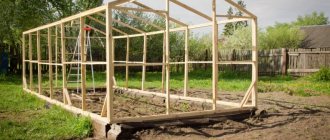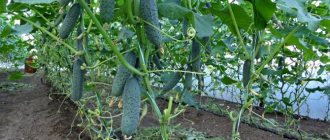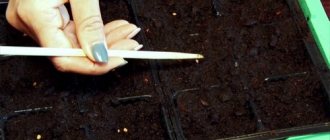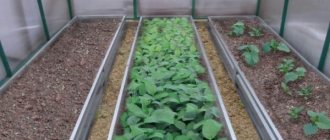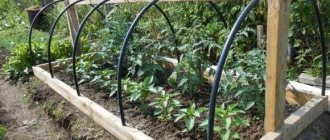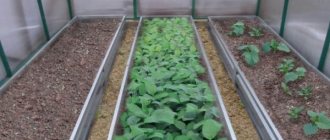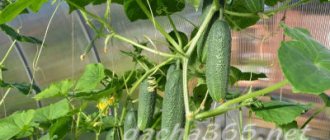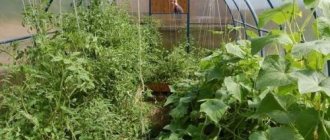OgorodGuruCom
Tips and tricks for gardeners
Popular
Where is corn grown and what kind of soil is needed?
Home › Vegetables › Compatibility of cucumbers and peppers for growing in the same greenhouse
Many experienced summer residents, trying to lengthen the growing season for various plants, use greenhouses and hotbeds. It’s just that there’s always not enough space in them. And it’s not possible to build or buy many greenhouses. Therefore, the question of compatibility between different cultures arises. For example, is it possible to plant cucumbers and peppers in the same greenhouse? It will be useful to answer such an important question.
Is it possible to plant peppers and cucumbers in one greenhouse?
Of course you can. After all, these cultures are very similar. The conditions of their maintenance and comfortable conditions for growth are the same. They can also be fed with the same fertilizers. The percentage of humidity in a polycarbonate greenhouse should not exceed sixty percent. Also, if you grow these crops nearby, and also if eggplants grow nearby, they must be treated with various drugs against crop diseases.
There is another very important point: cucumbers spread their shoots and foliage very quickly, based on this, you can understand that they need more space than peppers. Therefore, when planting adjacently, it is recommended to leave free space between crops. Initially, you can plant eggplants with cucumbers, and then peppers.
The similarity of these crops is also that they do not like cold drafts and strong winds. You also don’t have to worry about watering, it is the same for these crops. It will not turn out that some will have too little moisture, and others will have too much.
Peppers are susceptible to diseases such as powdery mildew. But don't worry that cucumbers can get it. Cucumbers are very rarely affected by it.
Varieties of hot peppers for joint planting
There are many varieties of hot pepper, but the following high-yielding varieties are considered the most suitable for growing together with cucumber:
- Aleksinsky - early ripening (fruits ripen in 145 days);
- Astrakhansky 147 – ripening lasts 122 days;
- Vizier – average ripening time;
- Miracle of the Moscow Region is an early ripening variety.
Knowledge of the characteristics of the crop and its compatibility with other plants will allow you to properly plan plantings and get good results. Hot peppers and cucumbers on the same ridge and in a greenhouse can coexist perfectly and produce high yields if you care for them properly.
How to combine vegetable crops in one greenhouse
When planting, it is important to observe not only the correct proximity. It is also important to properly care for and create comfortable conditions. If these factors are not observed, the harvest may be of low quality and small quantity.
How to plant correctly? Before planting, you need to stratify both the soil and planting material. You also need to disinfect it in advance. The seeds of all neighboring crops need to be disinfected. Cucumbers, peppers, and also eggplants if you are going to grow them nearby.
The soil mixture also plays an important role in the process. It can be the same for both peppers and cucumbers. Immediately before planting, peat or rotted manure should be added to the prepared hole. You can also add sawdust as an absorber of excess liquid.
When growing in greenhouses, you need to think about artificial pollination of crops. In good weather, you can open the window and door in the greenhouse. Another good way is to install a beehive. But as soon as the ovaries begin to form, the hive will need to be removed from the greenhouse. It is also very important to add both complex mineral fertilizers and organic fertilizers to the soil. This is important for all neighboring crops.
Conditions for separating vegetables
Probably every summer resident who was interested in growing different crops together has heard that it is advisable to separate them. This is indeed true and it will be useful to understand the issue in more detail.
An easy way to separate
Of course, the simplest solution in this situation is to simply separate the crops with paths. In most cases, this is quite enough - a distance of 90 cm ensures that one crop will not cause the slightest problem to another. It is not surprising that most summer residents prefer this method.
Cucumbers can also be grown with other nightshades.
Dividing the greenhouse with a partition
But experienced gardeners prefer to use partitions for separation. In this case, you can reduce the distance between the beds to 50-60 cm, saving a lot of useful space. Partitions are needed because peppers like less moist soil than cucumbers.
You can use ordinary slate as partitions - it is not afraid of high humidity and can last for many decades.
Fertilizers and fertilizers
They may be the same across cultures. For example, the following are suitable: 1) Fertilizers with nitrogenous elements; 2) Fertilizers with phosphorus elements; 3) Fertilizers with potassium elements.
The first fertilizing should be done immediately after planting. Chicken droppings or rotted manure are excellent for this purpose. The required amount must be mixed with ten liters of water, and then watered over the crops. During the fertilizing process, you need to carefully monitor the condition of the plants. If crops actively grow foliage, but do not form fruits at all, then you need to stop fertilizing them.
Growing together: how to plant?
Proper placement of beds with vegetable crops will allow them to be grown in one greenhouse. How to distribute territory:
- Peppers are planted on the south side of the greenhouse because they are quite heat-loving;
- It is preferable to plant tomato bushes in the center of the greenhouse, since this area is well ventilated. They can also be placed next to doors and opening windows, since drafts are not a problem for them;
- The northern part is suitable for planting cucumbers; this promotes the slow evaporation of moisture from their leaves and soil. Cucumbers are planted in the most secluded corners of the greenhouse, where there are no drafts.
How can you grow peppers and cucumbers in one greenhouse?
To avoid the risk of all kinds of diseases, cross-pollination, and attacks by insect pests, you need to follow some rules: 1) It is necessary to designate the space between the crops, so they will not interfere with each other. You can tread paths and lay wooden planks on them; 2) Some gardeners divide the space using plastic film. Yes, this is a fairly simple and inexpensive method, although not entirely productive; 3) The most ideal option would be polycarbonate partitions. When using it, it will be possible to create for each crop its own microclimate. Which of course will have a positive impact on the quantity and quality of the future harvest.
Rules of care
Producing a good harvest requires the right conditions for each plant.
Therefore, gardeners should listen to the advice:
- if cucumbers are planted before May, then additional heating is required, since there is a possibility of frosts that negatively affect the growing season of crops;
- It is advisable to use a polycarbonate greenhouse;
- fertile soil is prepared and fertilizers are applied, which allows you to get a good harvest in a short period of time;
- to form bushes, the plant placement pattern is taken into account;
- the process consists of eliminating the crown bud and pinching;
- Unnecessary leaves are periodically removed and pinched.
Attention! On a packet of seeds, rules for planting are often given, for which the selected variety is taken into account.
Plants that grow well next to cucumbers
Plants that are well suited for growing next to cucumbers include, first of all, legumes. Peas, beans and clover have root systems that colonize Rhizobium bacteria and fix atmospheric nitrogen, which is then converted to nitrates. Some is used to grow legumes, and some ends up in the surrounding soil as the plant decomposes and is available to any companion plants that grow nearby. It may also be smarter to use a shared rack for both green beans and cucumbers.
Good neighbors for cucumbers: broccoli and cauliflower, corn, lettuce, peas, beans, radishes, onions, sunflowers.
Flowers other than sunflowers can also be useful to plant next to cucumbers. Marigolds repel beetles, and nasturtiums help against aphids and other insects. Tansy also repels ants, beetles, flying insects and other insects.
Expert opinion
Since most summer residents have small plots of land, the issue of mixed cultivation is always relevant. The advantages of this method of growing plants are obvious and, with proper planning, they allow you to grow peppers and eggplants in the same greenhouse and combine other plants in the same bed. Crop rotation with mixed plantings improves significantly, the soil improves its composition, and the plants improve the taste of the fruit and nutritional value. The incidence is reduced, and the harvest pleases the owners
It is important to correctly position the plantings in the garden so that they do not oppress each other.
Growing peppers using “lazy” technology Surprisingly, peppers can be quickly and easily grown at your summer cottage in open ground. Tasty and healthy...
Peppers and eggplants can be successfully grown in the same greenhouse. They are similar in many aspects of care. Only pepper tolerates light shade and can be planted on a side that is not the sunniest. Eggplants are planted only on the south side. The harvest in a greenhouse is obtained earlier than in open ground. Sweet peppers may only turn slightly blue; bitter paprika cannot be planted in a bed of eggplants due to cross-pollination. I have marigolds planted at the entrance to the greenhouse.
Crop rotation involves an annual change of plantings in the beds. Peppers and eggplants in the same greenhouse can be planted after cucumbers. These are good predecessors because:
- the land turns out to be well fertilized;
- no weeds;
- the soil is soft, light, as required.
Please note! Yields in open ground increase after zucchini, carrots, squash, pumpkin, beets and garlic with onions. This planting promotes healthy growth of eggplants and peppers.
Growing peppers and eggplants in a greenhouse gives a high yield in the middle zone
It is possible to plant eggplants and peppers together by following simple care rules.
It is important to maintain a distance between the beds and the plants so that the seedlings have space and the owner can easily care for the blueberries and peppers. These cultures are compatible. Growing peppers and eggplants in a greenhouse gives a high yield in the middle zone
It is possible to plant eggplants and peppers together by following simple care rules.
Growing peppers and eggplants in a greenhouse gives a high yield in the middle zone. It is possible to plant eggplants and peppers together by following simple care rules.
It is important to maintain a distance between the beds and the plants so that the seedlings have space and the owner can easily care for the blueberries and peppers. These cultures are compatible
Vegetable grower secrets
Bitter chili is a spice that contains substances that “burn” our taste buds in the mouth when eaten. Everyone knows that after cutting chili, you should not touch your face with your hands, since when the substances get on the mucous membranes they cause a strong burning sensation. And the main “hot” components are contained in the white veins and chili seeds. Therefore, when working with bitter chili seeds (soaking, sowing), experienced gardeners wear rubber or latex gloves.
At greenhouse plants that grow hot peppers, workers wear masks during flowering and harvesting. Excessive inhalation of pollen from this vegetable can cause a severe autoimmune allergic reaction.
Having grown chili in a pot, you should remember that you cannot leave it on the windowsill in the kitchen. It grows best on a well-lit and glassed balcony.
Long road to popularity
Any living organism, be it a plant or an animal, is endowed by nature with a certain genetic code that determines its properties and requirements for its habitat.
Selection work with seed material carried out over many decades has made it possible to change and improve the appearance and taste of vegetables.
But very rarely they give the opportunity to change their requirements for the growing environment, although some plants can adapt to changing conditions in nature through mutation processes.
Hot India with high humidity is the homeland of cucumber. It still grows wild in those places.
Images of cucumber were found on the frescoes of Ancient Egypt and Greek temples. Known in such ancient times in other countries, the vegetable in Russia was first mentioned in printed sources in the 16th century.
The cucumber supposedly came to us from East Asia, but surprisingly it caught our taste and became a truly national product.
Abundant harvests of cucumbers are grown in most parts of the country - in greenhouses and on the ground. And then, with love and effort, they prepare cucumbers for eating all year round.
Wild tomatoes were first discovered in South America during the expedition of Christopher Columbus, and their seeds were brought to Europe for their ornamental value. At home, tomato thickets were found on dry and ventilated mountain slopes. The climate of those places was ideal for tomatoes - soft, moderate, with rare heavy rains. The 24-hour temperature ranged from 20 to 25 degrees Celsius.
REFERENCE: In Holland, France and Germany, tomatoes were grown in the greenhouses of wealthy people and planted for decoration in gardens and near gazebos. Their fruits were considered poisonous. It was only in 1811 that the German Botanical Dictionary published information on its pages that tomatoes can be eaten.
Tomato seeds came to Russia under Catherine II, but only at the beginning of the 19th century they began to be grown in the southern regions of the country as an edible crop and good yields were obtained.

